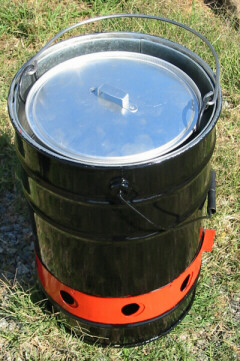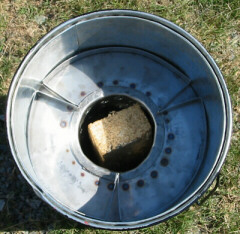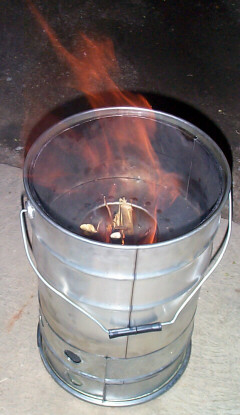 |
BASINTUTHU STOVE | |||||||||
|
The Basintuthu Stove is a fuel efficient wood stove based on a 25 litre paint can. Basintuthu means "makes fire from smoke" in SiSwati. This is a reference to the combustion of the smoke in the upper part of the fire (secondary combustion). An advantage this stove has over the Tsotso Stove is that the heat normally lost to the stove body below the pot is captured by the incoming air. This means there is a certain amount of pre-heating of the primary air. There is no attempt made to insulate the stove body. The heat that might ordinarily be radiated away is instead allowed to enter the hollow side walls of the stove where it heats the incoming air. The preheating of the primary air allows the stove to burn fuels that have a low pyrolization temperature far more efficiently. As the secondary air is also preheated, the effective combustion of biomass fuels like low density briquettes and dung, or dung-bound biomass improves significantly. Cooking can be accomplished with large weed stems, charcoal, coal, sawdust briquettes, paper briquettes, dry roots and even bound, chopped grass. Of course, wood is a preferred fuel. The best shape is a fat short chunk. The power output of the stove can be controlled by choosing fuel that matches the power requirement. Small, light fuel with a large surface-area-to-volume ratio burns faster and with a higher heat output than large heavy fuel. The stove is designed to use flat-bottomed pots and three legged cast iron pots up to size 2 (2 gallons). The cross piece is the support for pots. The handles allow the stove to be moved around even when the fire is burning. The rotating section with holes in it wrapped around the can controls the air supply to the whole fire. There is no separate control for the secondary air. A significant amount of variation in fire temperature is possible. The "power phase" of cooking requires far more heat than the "simmering phase". Closing the air control door can reduce the heat output by a factor of 5 or more. The construction of this simple stove features primary combustion, secondary combustion, pre-heated primary and secondary air injection and significant air control and can deliver a remarkable 35% total system efficiency (total available wood heat energy measured against heat delivered into a pot of water). A person who collects firewood every other day (a common scenario) will now only need to fetch wood once a week. The bottom view shows the lower air entry holes and the airway for pre-heating the secondary combustion air. Ash from the fires drops straight down onto the ground. Combustion tends to be very complete and almost smokeless due to re-ignition of the primary combustion products. An hour of cooking with wood typically produces 10 to 30 grams of charcoal. The Basintuthu Stove consists of four main components: - the main stove body - the fire grate with holes punched through it - the cross piece to support the pots. - the air control strip wrapped around the stove body.
|
Air control almost fully open, pot in place. Top view showing the folded strip pot stand and the inner heat shield for insulation. It increases the pot sidewall temperature.  An experimental Basintuthu with unheated primary air and separately controlled partially preheated secondary air. In this photo the flames indicate that the secondary air supply was inadequate for the amount and type of fuel in the firebox (lots of small acacia branches).  |
|||||||||
| << Back | ||||||||||